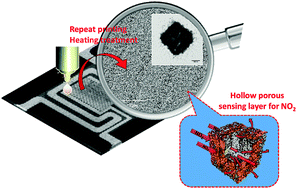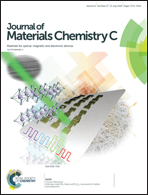Cu2O@PNIPAM core–shell microgels as novel inkjet materials for the preparation of CuO hollow porous nanocubes gas sensing layers†
Abstract
There has been long-standing interest in developing metal oxide-based sensors with high sensitivity, selectivity, fast response and low material consumption. Here we report for the first time the utilization of Cu2O@PNIPAM core–shell microgels with a nanocube-shaped core structure for construction of novel CuO gas sensing layers. The hybrid microgels show significant improvement in colloidal stability as compared to native Cu2O nanocubes. Consequently, a homogeneous thin film of Cu2O@PNIPAM nanoparticles can be engineered in a quite low solid content (1.5 wt%) by inkjet printing of the dispersion at an optimized viscosity and surface tension. Most importantly, thermal treatment of the Cu2O@PNIPAM microgels forms porous CuO nanocubes, which show much faster response to relevant trace NO2 gases than sensors produced from bare Cu2O nanocubes. This outcome is due to the fact that the PNIPAM shell can successfully hinder the aggregation of CuO nanoparticles during pyrolysis, which enables full utilization of the sensor layers and better access of the gas to active sites. These results point out great potential of such an innovative system as gas sensors with low cost, fast response and high sensitivity.



 Please wait while we load your content...
Please wait while we load your content...